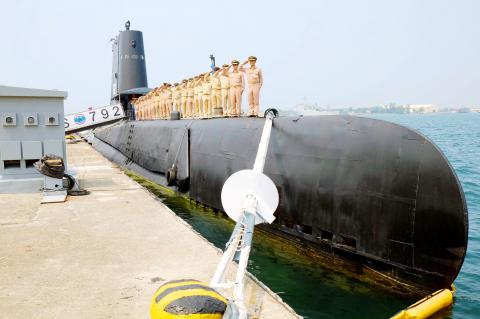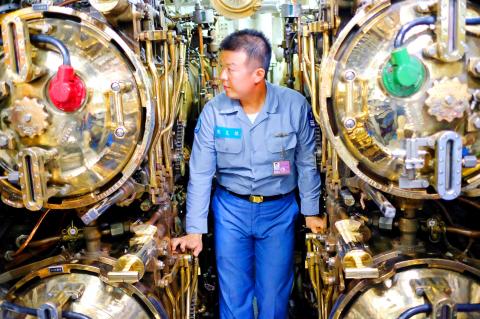At 70 years old, Taiwan’s World War II-era Hai Pao submarine would not be out of place in a museum, but the antique vessel is still part of the navy — a sign of the nation’s ongoing struggle to strengthen its fleet.
The sub’s interior gleams with highly polished copper and is the pride of its crew, but the fact that the former US warship is still on active duty is testament to Taiwan’s decades-long battle to build up its submarine force, with potential suppliers wary of jeopardizing relations with China.
China has opposed any arms sales to Taiwan.

Photo: AFP
Yet a modern submarine fleet is critical for Taiwan’s defense, analysts say.
“Submarines would be a credible, survivable deterrent to an opponent’s use of force and thus make use of force less likely,” said Mark Stokes, executive director of the Project 2049 Institute, a US-based think tank on Asian security and public policy. “They would complicate [China’s] People’s Liberation Army planning in a variety of scenarios.”
Then-US president George W. Bush approved the sale of eight conventional submarines to Taiwan in April 2001, but they never materialized as Washington focused on its development of nuclear subs.

Photo: AFP
Germany and Spain, two of the world’s few submarine exporting countries, have also declined to supply Taiwan in what commentators interpret as fear of offending China.
Aside from two aging subs built in the 1940s, Taiwan’s navy operates two other Dutch-built submarines which were commissioned in the late 1980s.
The number is in stark contrast to the Chinese navy, which now owns more than 60 submarines, including 14 that are nuclear-powered.
An official evaluation this year of a potential domestic submarine-building project was “pretty positive,” Chinese Nationalist Party (KMT) Legislator Lin Yu-fang (林郁方) said, who sits on the legislature’s Foreign Affairs and National Defense Committee.
“The government might set aside a budget to officially launch the Indigenous Defense Submarine project,” he said, though the proposals have yet to be given the green light.
Taiwan is seeking to collaborate with the US on the project, Lin said.
The US remains the nation’s leading arms supplier, despite a lack of diplomatic ties.
Taiwan produced 130 Indigenous Defense Fighter (IDF) jets with technological aid from the US in the 1990s.
That project came after the US had refused to sell jet fighters to Taiwan, under pressure from Beijing.
Lin and a legislative group recently returned from Washington, where they discussed defense supply plans with government officials and representatives, focusing on the potential sub program.
“They used to be cold on the issue [of submarines], but this time was different. They were listening attentively when we raised the issue again. They have changed their attitude because we have become active on the deal,” Lin said.
Supporters of the project say Washington could reduce political pressure from Beijing if it supplies fighting systems and know-how, rather than the new submarines themselves.
For now, Taiwan’s two World War II-era Guppy submarines — including the Hai Pao. whose name means “Seal” — remain central to their fleet.
Taiwan bought the Hai Pao, then called Tusk, from the US in 1973 and the vintage sub recently returned from the nation’s biggest annual naval war game.
The fleet also includes the aging Hai Shih, or “Sea Lion” — another former US submarine built in the 1940s.
Captain of the Hai Pao Liu Si-wei said that his US peers were astonished to hear the antique subs were still in service.
Liu finished an advanced submarine officer training program in the US last year and several of his classmates are now captains of US nuclear-powered submarines.
“When they heard that the two submarines were still on active duty, several of my classmates said: ‘Fantastic.’ They told me, if permitted, they would like very much to have a look at them,” Liu said from on board the Hai Pao, which was docked at the Tso-ying naval base.
The navy is planning to spend more than NT$800 million (US $26.35 million) to overhaul one of the old subs next year.
Both will get new hulls as they are currently unable to dive more than 20m — less than a 10th of their design depth — due to warped pressure hulls and metal fatigue.
Taiwan’s ultimate ambitions to build its own subs are not pie in the sky, says Stokes — Taiwan has already built a 400,000-tonne oil tanker and seven navy frigates, among other vessels.
“The submarine program would mostly likely be based on a new design or a significant modification of an existing design,” Stokes said.
“Taiwan’s shipbuilding industry is one of the best in the world,” he said.

Starlux Airlines, Taiwan’s newest international carrier, has announced it would apply to join the Oneworld global airline alliance before the end of next year. In an investor conference on Monday, Starlux Airlines chief executive officer Glenn Chai (翟健華) said joining the alliance would help it access Taiwan. Chai said that if accepted, Starlux would work with other airlines in the alliance on flight schedules, passenger transits and frequent flyer programs. The Oneworld alliance has 13 members, including American Airlines, British Airways, Cathay Pacific and Qantas, and serves more than 900 destinations in 170 territories. Joining Oneworld would also help boost

A new tropical storm formed late yesterday near Guam and is to approach closest to Taiwan on Thursday, the Central Weather Administration (CWA) said. Tropical Storm Pulasan became the 14th named storm of the year at 9:25pm yesterday, the agency said. As of 8am today, it was near Guam traveling northwest at 21kph, it said. The storm’s structure is relatively loose and conditions for strengthening are limited, WeatherRisk analyst Wu Sheng-yu (吳聖宇) said on Facebook. Its path is likely to be similar to Typhoon Bebinca, which passed north of Taiwan over Japan’s Ryukyu Islands and made landfall in Shanghai this morning, he said. However, it

Taiwan's Gold Apollo Co (金阿波羅通信) said today that the pagers used in detonations in Lebanon the day before were not made by it, but by a company called BAC which has a license to use its brand. At least nine people were killed and nearly 3,000 wounded when pagers used by Hezbollah members detonated simultaneously across Lebanon yesterday. Images of destroyed pagers analyzed by Reuters showed a format and stickers on the back that were consistent with pagers made by Gold Apollo. A senior Lebanese security source told Reuters that Hezbollah had ordered 5,000 pagers from Taiwan-based Gold Apollo. "The product was not

COLD FACTS: ‘Snow skin’ mooncakes, made with a glutinous rice skin and kept at a low temperature, have relatively few calories compared with other mooncakes Traditional mooncakes are a typical treat for many Taiwanese in the lead-up to the Mid-Autumn Festival, but a Taipei-based dietitian has urged people not to eat more than one per day and not to have them every day due to their high fat and calorie content. As mooncakes contain a lot of oil and sugar, they can have negative health effects on older people and those with diabetes, said Lai Yu-han (賴俞含), a dietitian at Taipei Hospital of the Ministry of Health and Welfare. “The maximum you can have is one mooncake a day, and do not eat them every day,” Lai